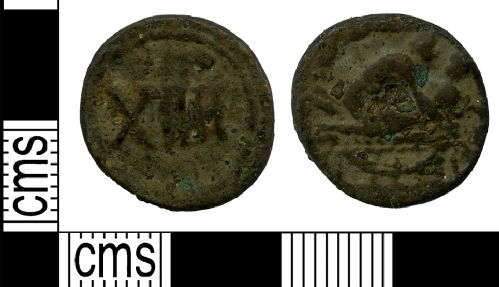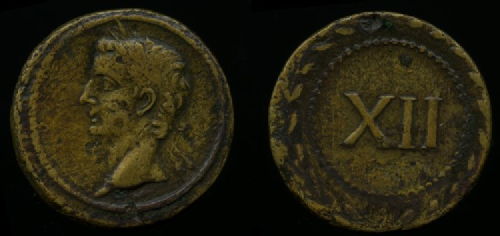All 2 entries tagged Livia
No other Warwick Blogs use the tag Livia on entries | View entries tagged Livia at Technorati | There are no images tagged Livia on this blog
February 01, 2019
Honours, Health and Hairstyles

Dupondius of Tiberius, Rome, AD 22-23. RIC I2 Tiberius 47, British Museum No. R.6361. Image reproduced courtesy of the Trustees of the British Museum.
This Roman copper alloy coin was produced in 22-23 AD, in the middle of Tiberius’ reign, and is held by the British Museum, but is not currently on display.
It is part of a series depicting a draped female bust, with the legend “SALVS AVGVSTA” on the obverse, while the reverse carries the abbreviation “S C”, signifying the coin was struck by a decree of the Senate, and the legend “TI.CAESAR.DIVI.AVG.F.AVG.P.M.TR.POT. XXIII”.
The obverse is understood to be a portrait of Livia Drusilla, wife of Augustus and Tiberius’ mother, who died in 29 AD, aged 86. While Livia was honoured with statues and portrait busts in her lifetime, there are no explicitly identifiable representations of her on contemporary imperial coins. Instead, depictions which may represent her on Roman imperial coins are ambiguous, carrying attributes which are identifiable with Ceres, or Pax – both of which are associated with Livia in various inscriptions, statues and possibly on the Ara Pacis. However, coins from provincial mints, particularly Greek and Egyptian, carry portraits with legends which do name her. This may partially be due to Augustus being cautious of imagery in Rome which could be construed as reflecting suggestions of monarchical ambitions. Although the idea of monarchy was abhorrent in Roman culture, it was much more acceptable and less contentious in societies in the eastern Mediterranean, which may explain why Livia was clearly portrayed there. Additionally, Marcus Antonius had featured women (Fulvia, Octavia and Cleopatra) on his coinage, and Augustus may have wished to both distance and differentiate himself from this for a variety of reasons (see August 2018 blog entry which discusses Fulvia).
Despite this, Augustus (then Octavian) had, in 35 BC, granted both Livia and his sister Octavia unprecedented honours: public protection comparable to that provided for tribunes; the right to manage their own estates without a guardian; and the right to honorific statues (see Cassius Dio, Roman History, 49.38.1). Honouring both Livia and Octavia thus had an underlying political motivation – by elevating them as paradigms of Roman matronly behaviour, Augustus obliquely, but publicly, reproached Marcus Antonius, who was living openly with Cleopatra in Egypt and mistreating Octavia, who he had married in 40 BC in an attempt to cement relations between himself and Octavian.
With the death and deification of Augustus in 14 AD, Livia had been adopted into the Julian family and was known as Julia Augusta, however the “Augusta” on the dupondius’ legend is not her name, but an adjective relating to “salus”. Tiberius gave his mother further honours, but vetoed attempts by the Senate to grant more titles to Livia – in this he followed Augustus’ lead, as he had granted Livia no official titles in his lifetime, again perhaps to avoid suggestions of monarchical ambitions. However, despite this, Livia was popularly, but unofficially, designated mater patriae (mother of her country).
In 22 AD, Livia had been seriously ill, and in view of her advancing years, her recovery was considered remarkable, and resulted in the Equestrian order dedicating a statue to Equestrian Fortune at Antium (see Tacitus Annals 3.71). The coin’s obverse legend “Salus Augusta”, is not a direct reference to this illness or recovery, although it may be understood to allude to it. Comparatively, Augustan coins from 16 BC commemorate vows for Augustus’ salus (health/safety), but on these the legend is clear “Salus Augusti”, with the genitive case clearly evidencing the salus belonged to Augustus. Instead, in this case, it is understood as being a reference to the good health of the state, and there may also be a politically-charged reference to this being dependent on Livia’s well-being.
Looking more closely at the portrait on the coin, Livia’s coiffure is arguably the most striking element. Parallel waves on the crown of her head from a central parting, connect to fuller waves across her forehead, becoming rolled braids which run from her temples to wrap the chignon, which sits at the back of her neck. Absent from this coiffure is the nodus - a wide knot of hair rolled forward to sit above the forehead.This was a defining characteristic in Livia’s portraiture in statuary prior to 14 AD.
This later hairstyle was softer and although the portrait may hint at Livia’s maturity via the fuller cheeks and perhaps the suggestion of a double chin, the overall impression is of idealised youthful Roman beauty – large eyes, an aquiline nose and strong mouth. At least four sculptural marble heads, which all date to the reign of Tiberius, match closely the coiffure shown on the Salus Augusta dupondii series, suggesting that this particular representation of Livia, not dissimilar to her coiffure on the Ara Pacis, had become more widely disseminated, although it is worth noting that the nodus portrait type of Livia was not replaced by this and continued to be used.
 |
This month's coin was written by Jacqui Butler. Jacqui has just completed the first year of the MA in Ancient Visual and Material Culture (part time), having gained a BA in Classical Studies with the Open University last year. Her main interests lie in the visual depictions of both mythical and real women in Roman material culture, specifically in art, but also their representation in epigraphy on funerary monuments.
Bibliography
Barratt, A.A. (2002) Livia: First Lady of Imperial Rome, Yale University Press.
Bartman, E. (1999) Portraits of Livia, Cambridge University Press.
Wood, S.E. (2001) Imperial Women, A Study in Public Images, 40 BC – AD68 (Mnemosyne, bibliotheca classica Batava, Supplementum 195).
August 01, 2015
Ain't talkin' 'bout love. Roman "Spintriae" in context.
 |
| Roman token, found in the Thames, PAS LON-E98F21 |
In 2012 this token was found in the Thames in London, resulting in numerous news articles about this 'brothel token'. The obverse carries the Roman numeral XIIII (14), while the reverse carries a sex scene. The couple are laying on a decorated bed or a couch, the woman laying on her front while a male straddles her.
This token is part of a broader series that carry a Roman numeral between 1 and 16 on one side, and various sex acts on the other. Another series carry Roman numerals on one side and portraits of Augustus, Tiberius or Livia on the other (see below). Buttrey analysed the dies of both series and concluded they were connected; he suggested that these objects date to the Julio-Claudian period and were perhaps gaming tokens, envisaging a possible scenario where one side played 'the imperial portraits' and the other 'the sex scenes', making the game a form of salacious gossip on the sex lives of the Roman emperors.
 |
| Roman token showing Tiberius and XII within wreath. |
In reality, we know very little about these objects; their sexual scenery has created numerous forgeries, and very few archaeological contexts are known. They are often called spintriae, a label created in the modern era from a reading of Suetonius' Life of Tiberius. As part of the portrayal of Tiberius' activities on Capri, Suetonius records the presence of numerous female and male prostitutes, called spintrias (Suet. Tib. XLIII, see also Tacitus, Ann. VI.1; sphinthria or spintria referred to a male prostitute in Latin, from the Greek σφιγκτήρ, and connected to the Latin/modern word sphincter). It is this tale that inspired early collectors and scholars to label these objects spintriae, and when a hoard of tokens was found on Capri it cemented the name, though they were not called this in antiquity.
Indeed, the known find contexts of these objects suggest they had little to do with sex. Although hundreds of these specimens exist (precise numbers are difficult given the quantity of fakes in existence), only a handful of closed archaeological contexts are known. We cannot know whether the Thames example was lost in antiquity, or more recently. But one example was recently found in a tomb in Mutina; associated ceramics and other coins dates the tomb to AD 22-57, suggesting Buttrey's dating of the Julio-Claudian period is correct. Another was found during an archaeological campaign on the island of Majsan; this was pierced, suggesting it had been transformed into a piece of jewellery. Scattered other examples are reported to have been found in Caesarea Maritima, in the Garigliano in Italy, on Skegness beach (likely a modern loss) and in Germany (Stockstadt am Main, Saalburg, Nendorp-Wischenborg; these are sporadic finds). Although the information on the find places of these objects leaves much to be desired, none of these find spots are brothels, and in each example there is only one 'spintria' found. What their purpose was remains a mystery. Like many Roman tokens, much more study is required before we can fully understand these objects.

This month's coin was chosen by Clare Rowan. Clare is a research fellow at Warwick, who has recently become interested in the role tokens had in Roman society.
Coin images above reproduced courtesy of the Portable Antiquities Scheme and © The Trustees of the British Museum
Select Bibliography:
Benassi, F., N. Giordani and C. Poggi (2003). Una tessera numerale con scena erotica da un contesto funerario di Mutina. Numismatica e Antichità classiche 32: 249-273.
Buttrey, T. (1973). The spintriae as a historical source. Numismatic Chronicle 13: 52-63.
Martini, R. (1997). Tessere numerali bronzee romane nelle civiche raccolte numismatiche del comune di Milano Parte I. Annotazione Numismatische Supplemento IX: 1-28.
Mirnik, I. (1985). Nalazi novca s Majsana. VAMZ 18: 87-96.
 Clare Rowan
Clare Rowan

 Please wait - comments are loading
Please wait - comments are loading

 Loading…
Loading…

